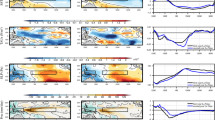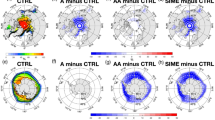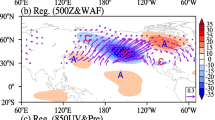Abstract
The sea surface temperature anomaly pattern differs between the central Pacific (CP) and eastern Pacific (EP) El Niños during boreal summer. It is expected that the respective atmospheric response will be different. In order to identify differences in the responses to these two phenomena, we examine the Community Atmosphere Model Version 4 simulations forced with observed monthly sea surface temperature during 1979–2010 and compare with the corresponding observations. For CP El Niño, a triple precipitation anomaly pattern appears over East Asia. During EP El Niño, the triple pattern is not as significant as and shifts eastward and southward compared to CP El Niño. We also examine the influence of CP La Niña and EP La Niña on East Asia. In general, the impact of CP (EP) La Niña on tropics and East Asia seems to be opposite to that of CP (EP) El Niño. However, the impacts between the two types of La Niña are less independent compared to the two types of warm events. Both types of El Niño (La Niña) correspond to a stronger (weaker) western North Pacific summer monsoon. The sensitivity experiments support this result. But the CP El Niño (La Niña) may have more significant influence on East Asia summer climate than EP El Niño (La Niña), as the associated low-level anomalous wind pattern is more distinct and closer to the Asian continent compared to EP El Niño (La Niña).











Similar content being viewed by others
Change history
04 October 2017
An erratum to this article has been published.
References
Adler RF, Huffman GJ, Chang A et al (2003) The version 2 Global Precipitation Climatology Project (GPCP) monthly precipitation analysis (1979-present). J Hydrometeor 4:1147–1167
Ashok K, Yamagata T (2009) The El Niño with a difference. Nature 461:481–484
Ashok K, Behera SK, Rao SA, Weng HY, Yamagata T (2007) El Niño Modoki and its teleconnection. J Geophys Res 112:C11007. doi:10.1029/2006JC003798
Chen GH, Tam CY (2010) Different impacts of two kinds of Pacific Ocean warming on tropical cyclone frequency over the western North Pacific. Geophys Res Lett 37:L01803. doi:10.1029/2009GL041708
Collins WD, Rasch PJ, Boville BA, Hack JJ, McCaa JR, Williamson DL, Beriegleb BP (2006) The formulation and atmospheric simulation of the Community Atmosphere Model version 3 (CAM3). J Clim 19:2144–2161
Dee DP, Uppala SM, Simmons AJ et al (2011) The ERA-Interim reanalysis: configuration and performance of the data assimilation system. Q J R Meteorol Soc 137:553–597
Diaz HF, Hoerling MP, Hurrell JW (2001) ENSO variability, teleconnections and climate change. Int J Climatol 21:1845–1862
Enfield DB, Luis CS (1991) Low-frequency changes in El Niño –Southern Oscillation. J Clim 4:1137–1146
Fan L, Shin SI, Liu Q et al (2013) Relative importance of tropical SST anomalies in forcing East Asian summer monsoon circulation. Geophys Res Lett 40:2471–2477. doi:10.1002/grl.50494
Feng J, Li JP (2011) Influence of El Niño Modoki on spring rainfall over south China. J Geophys Res 116:D13102. doi:10.1029/2010JD015160
Fu C, Diaz HF, Fletcher JO (1986) Characteristics of response of sea-surface temperature in central Pacific associated with warm episodes of the Southern Oscillation. Mon Wea Rev 114:1716–1738
Gent PR, Danabasoglu G, Donner LJ et al (2011) The Community Climate System Model version 4. J Clim 24:4973–4991. doi:10.1175/2011JCLI4083.1
Horii T, Hanawa K (2004) A relationship between timing of El Niño onset and subsequent evolution. Geophys Res Lett 31:L06304. doi:10.1029/2003GL019239
Huang RH, Li WJ (1988) Influence of heat source anomaly over the western tropical Pacific on the subtropical high over East Asia during summer and its physical mechanism. Chin J Atmos Sci 12:107–117 (in Chinese)
Hurrell JW, Hack JJ, Shea D, Caron JM, Rosinski J (2008) A new sea surface temperature and sea ice boundary dataset for community atmosphere model. J Climate 21:5145–5153. doi:10.1175/2008JCLI2292.1
Kao HY, Yu JY (2009) Contrasting eastern-Pacific and central-Pacific types of ENSO. J Clim 22:615–632
Kug JS, Ham YG (2011) Are there two types of La Nina? Geophys Res Lett 38:L16704. doi:10.1029/2011GL048237
Kug JS, Jin FF, An SL (2009) Two types of El Niño events: cold tongue El Niño and warm pool El Niño. J Clim 22:1499–1515
Larkin NK, Harrison DE (2005) On the definition of El Niño and associated seasonal average U.S. weather anomalies. Geophys Res Lett 32:L13705. doi:10.1029/2005GL022738
Lee T, McPhaden MJ (2010) Increasing intensity of El Niño in the central-equatorial Pacific. Geophys Res Lett 37:L14603. doi:10.1029/2010GL044007
Mantua NJ, Hare SR, Zhang Y et al (1997) A Pacific interdecadal climate oscillation with impacts on salmon production. Bull Am Meteorol Soc 78:1069–1079
Meehl GA, Covey C, Delworth T et al (2007) The WCRP CMIP3 multimodel dataset: a New Era in Climate Change Research. Bull Am Meteorol Soc 88:1383–1394
Neale RB, Richter J, Park S, Lauritzen PH, Vavrus SJ, Rasch PJ, Zhang M (2013) The mean climate of the Community Atmosphere Model (CAM4) in forced SST and fully coupled experiments. J Clim e-View. doi:10.1175/JCLI-D-12-00236.1
Nitta T (1987) Convective activities in the tropical western Pacific and their impact on the Northern Hemisphere summer circulation. J Meteor Soc Jpn 65:373–390
Rasmusson EM, Carpenter TH (1982) Variations in tropical sea surface temperature and surface wind fields associated with the Southern Oscillation/El Niño. Mon Wea Rev 110:354–384
Rayner NA, Parker DE, Horton EB et al (2003) Global analyses of SST, Sea ice and night marine air temperature since the late nineteenth century. J Geophy Res 108(D14):4407. doi:10.1029/2002JD002670
Sun XG, Yang XQ (2005) Numerical modeling of interannual anomalous atmospheric circulation patterns over East Asia during different stages of an El Nino event. Chin J Geophys (Chinese) 48:501–510
Taylor KE (2001) Summarizing multiple aspects of model performance in a single diagram. J Geophys Res 106:7183–7192
Trenberth KE (1997) The definition of El Niño. Bull Am Meteor Soc 78:2771–2777
Trenberth KE, Stepaniak DP (2001) Indices of El Niño evolution. J Clim 8:1697–1701
Wang B (1995) Interdecadal changes in El Niño onset in the last four decades. J Clim 8:267–285
Wang B, Fan Z (1999) Choice of south Asian summer monsoon indices. Bull Am Meteorol Soc 80:629–638
Wang CZ, Fiedler PC (2006) ENSO variability and the eastern tropical Pacific: a review. Prog Ocean 69:239–266
Wang B, Lin H (2002) Rainy season of the Asian-Pacific summer monsoon. J Clim 15:386–396
Wang B, Huang F, Wu ZW, Yang J, Fu Xh, Kikuchia K (2009) Multi-scale climate variability of the South China Sea monsoon: a review. Dyn Atmos Ocean 47:15–37
Wang CZ, Li CX, Mu M, Duan WS (2012) Seasonal modulations of different impacts of two types of ENSO events on tropical cyclone activity in the western North Pacific. Clim Dyn. doi:10.1007/s00382-012-1434-9
Weng HY, Ashok K, Behera SK, Rao SA, Yamagata T (2007) Impacts of recent El Niño Modoki on dry/wet conditions in the Pacific Rim during boreal summer. Clim Dyn 29:113–129. doi:10.1007/s00382-007-0234-0
Weng HY, Wu GX, Liu YM, Behera SK, Yamagata T (2011) Anomalous summer climate in China influenced by the tropical Indo-Pacific Oceans. Clim Dyn 36:769–782. doi:10.1007/s00382-009-0658-9
Wu R, Kirtman BP, Pegion K (2006) Local Air–Sea relationship in observation and model simulations. J Clim 19:4914–4932
Wu W, Wen ZP, Wu R, Wang TM (2011) Air–Sea interaction over the subtropical North Pacific during the ENSO transition phase. J Clim 24:5772–5785
Xu GY, Yang XQ, Sun XG (2005) Interdecadal and interannual variation characteristics of rain fall in North China and its relation with the northern hemisphere atmospheric circulations. Chin J Geophys (Chinese) 48:511–518
Yang XQ, Zhu YM (2008) Interdecadal climate variability in China associated with the Pacific Decadal Oscillation. In: Fu C et al (eds) Regional climate studies of China. Springer, New York, pp 97–118
Yang XQ, Xie Q, Zhu YM et al (2005) Decadal-to-interdecadal variability of precipitation in North China and associated atmospheric and oceanic anomaly patterns. Chin J Geophys (Chinese) 48:789–797
Yeh SW, Kug JS, Dewitte B, Kwon MH, Kirtman BP, Jin FF (2009) El Niño in a changing climate. Nature 461:511–514
Yu JY, Kao HK (2007) Decadal changes of ENSO persistence barrier in SST and ocean heat content indices: 1958–2001. J Geophys Res 112:D13106. doi:10.1029/2006JD007654
Yuan Y, Yang S (2012) Impacts of different types of El Niño on the East Asian climate: focus on ENSO cycles. J Clim 25:7702–7722
Zhang Y, Wallace JM, Battisti DS (1997) ENSO-like interdecadal variability: 1900–1993. J Clim 10:1004–1020
Zhang X, Sheng J, Shabbar A (1998) Modes of interannual and interdecadal variability of Pacific SST. J Clim 11:2556–2569
Zhu YM, Yang XQ (2003a) Joint propagating patterns of SST and SLP anomalies in the North Pacific on bidecadal and pentadecadal timescales. Adv Atmos Sci 20:694–710
Zhu YM, Yang XQ (2003b) Relationships between Pacific Decadal Oscillation and climate variabilities in China. Acta Meteor Sinica (Chinese) 61:641–654
Zhu YM, Yang XQ, Chen XY, Zhao SS, Sun XG (2007) Interdecadal variation of the relationship between ENSO and summer interannual climate variability in China. J Trop Meteorol 13:132–136
Acknowledgments
This research is jointly supported by the National Natural Science Foundation of China (Grant No. 41175076) and the National Key Basic Research Program of China (Grant No. 2009CB421404). RW acknowledges the support of a Hong Kong Research Grants Council grant (CUHK403612) and the National Natural Science Foundation of China (41275081). ZC acknowledges the support of the high-performance grid computing platform of Sun Yat-sen University.
Author information
Authors and Affiliations
Corresponding author
Additional information
An erratum to this article is available at https://doi.org/10.1007/s00382-017-3922-4.
Rights and permissions
About this article
Cite this article
Chen, Z., Wen, Z., Wu, R. et al. Influence of two types of El Niños on the East Asian climate during boreal summer: a numerical study. Clim Dyn 43, 469–481 (2014). https://doi.org/10.1007/s00382-013-1943-1
Received:
Accepted:
Published:
Issue Date:
DOI: https://doi.org/10.1007/s00382-013-1943-1




